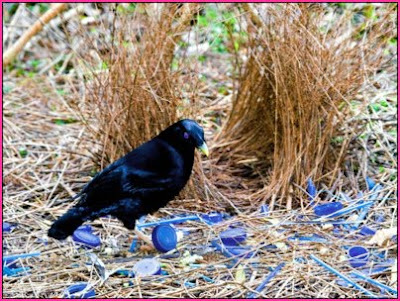 Part 1
Part 1Please read the following link:
http://en.wikipedia.org/wiki/Zelig
as we will be screen this film in class.
Part 2



Most of the ways that we explore color in this course are rooted in the cultural. this week we'll take a look at ways color operates in the natural world, specifically the animal and plant worlds, there is much of interest.
Phosphorescent, Florescent, Iridescent, and Interference Colors
These are examples of colors that cannot be recreated with basic artists paints. Phosphorescent and florescent are similar: they are colored materials that absorb light and re-emit it back out, appearing to glow. Phosphorescence re-emits at a slower rate of time. Iridescent and interference colors are those that appear to have hue changes from varying angles of perception due to surface properties and levels of transparency. These types of properties have been developed in paints and inks, so that the molecular structure of the colorants mimics that of the qualities of objects. Bioluminescence is the emmision of light by a living creature, such as a firefly.




Visible Spectrum of Ours and Other Species




 From a bee's-eye-view, the UV colors and patterns in a flower's petals show where the nectar and pollen are.
From a bee's-eye-view, the UV colors and patterns in a flower's petals show where the nectar and pollen are.
Color as Warning and/or Signal
Warning coloration-the opposite of camouflage-serves to render an animal conspicuous and rememberable to it's enemies.


Attraction (Food Supply)
Lungwort flowers change color with age from red to blue. Young red flowers have a significantly greater pollen and nectar reward and are significantly more often unpollinated than old blue ones. In this way, lungwort plants direct pollinators to reproductive, highly rewarding red flowers. Floral color change is a mechanism that increases the efficiency of pollen transfer.

Attraction (Mating)
Birds use plumage color to recognize and select potential mates. Through color and pattern, they can identify the same species.
As a part of a mating ritual, the male of this bird genus (sorry i forgot what kind of bird) gathers items all of a chosen color (seemingly at random), and brings the bits back to his nesting area. This is meant to let females know he is ready to mate.

Camouflage
A way of avoiding detection by other species, that allows an otherwise perfectly visible creature to become indiscernible in it's environment. This crab can change colors from bright to dull when it senses a predator.
 Roger Hanlon, a marine biologist at Woods Hole, Massachusetts who studies the camouflage skills of the cuttlefish and octopus, has found natural camouflage systems correspond to three disguise templates: uniform color, random patterns within a single color variation, and disruptive patterning that disguises the body outlines. These correspond to color, texture and outline as the three most important perceptual mechanisms for object perception. The first two mechanisms degrade the color and texture cues for outline, and the last degrades the cues for object recognition from perceptible outline.
Roger Hanlon, a marine biologist at Woods Hole, Massachusetts who studies the camouflage skills of the cuttlefish and octopus, has found natural camouflage systems correspond to three disguise templates: uniform color, random patterns within a single color variation, and disruptive patterning that disguises the body outlines. These correspond to color, texture and outline as the three most important perceptual mechanisms for object perception. The first two mechanisms degrade the color and texture cues for outline, and the last degrades the cues for object recognition from perceptible outline.








Working in pairs, create a camouflage pattern on a sheet of Bristol that hides in an environment on the 5th floor. When complete, the class will judge the effectiveness of each team's camouflage.
• You will choose work-partner(s).
• You must use a full sheet of paper (9"x12"), no cutting it down.
•You will adhere with tape or other temporary adhesive.
• Your chosen site and subsequent sheet must utilize at least three color/texture areas.
• You may not use the bathrooms, stairways or otherwise block a fire exit.
Due Monday, February 21.
No comments:
Post a Comment